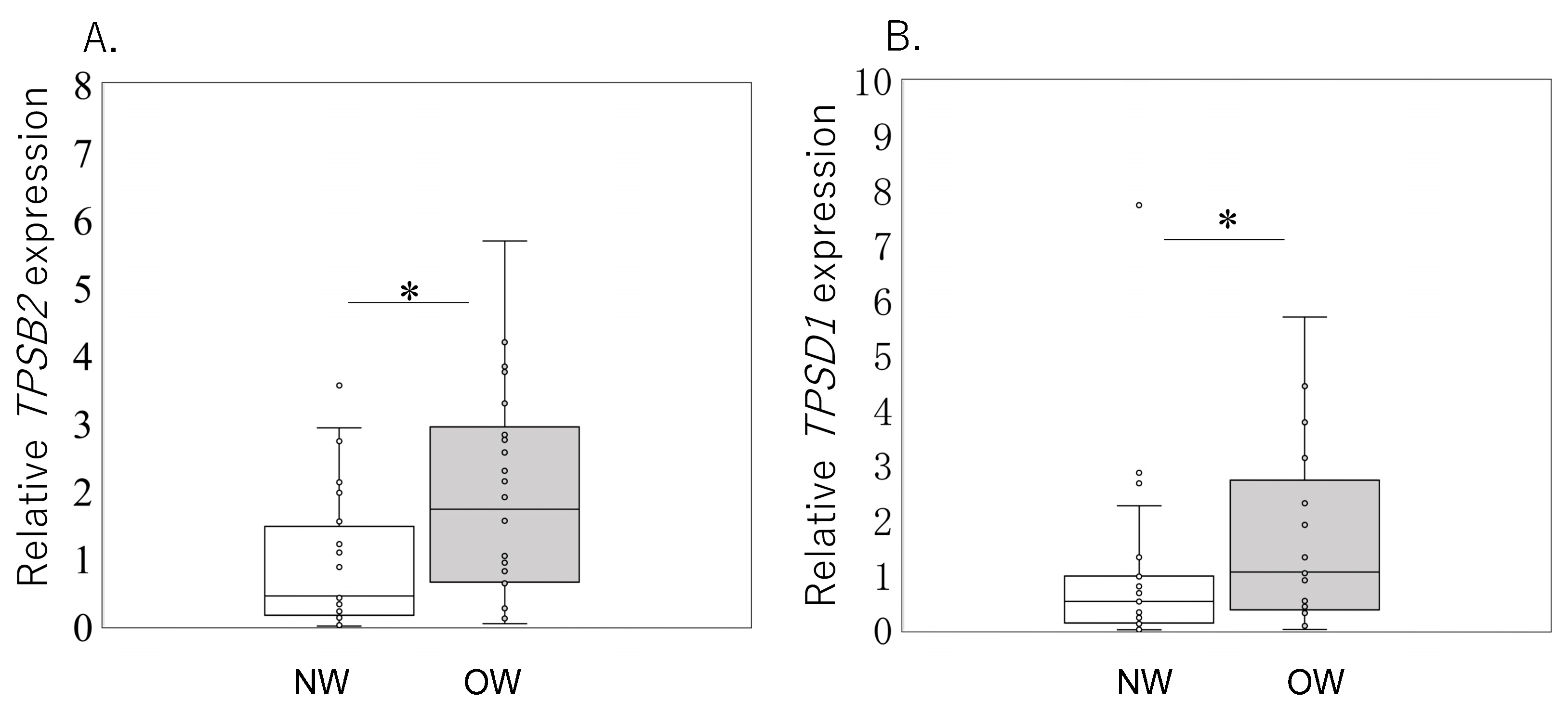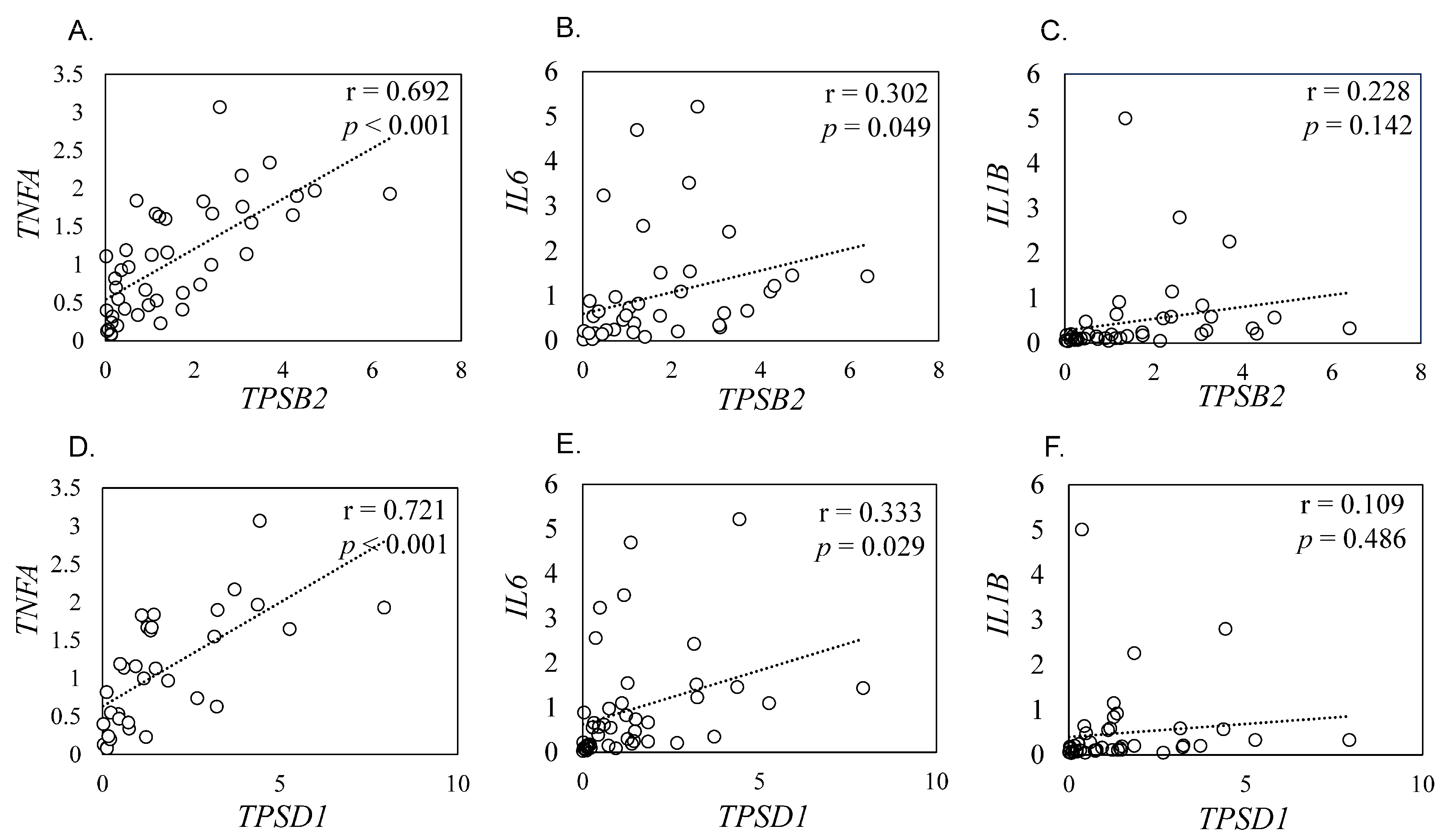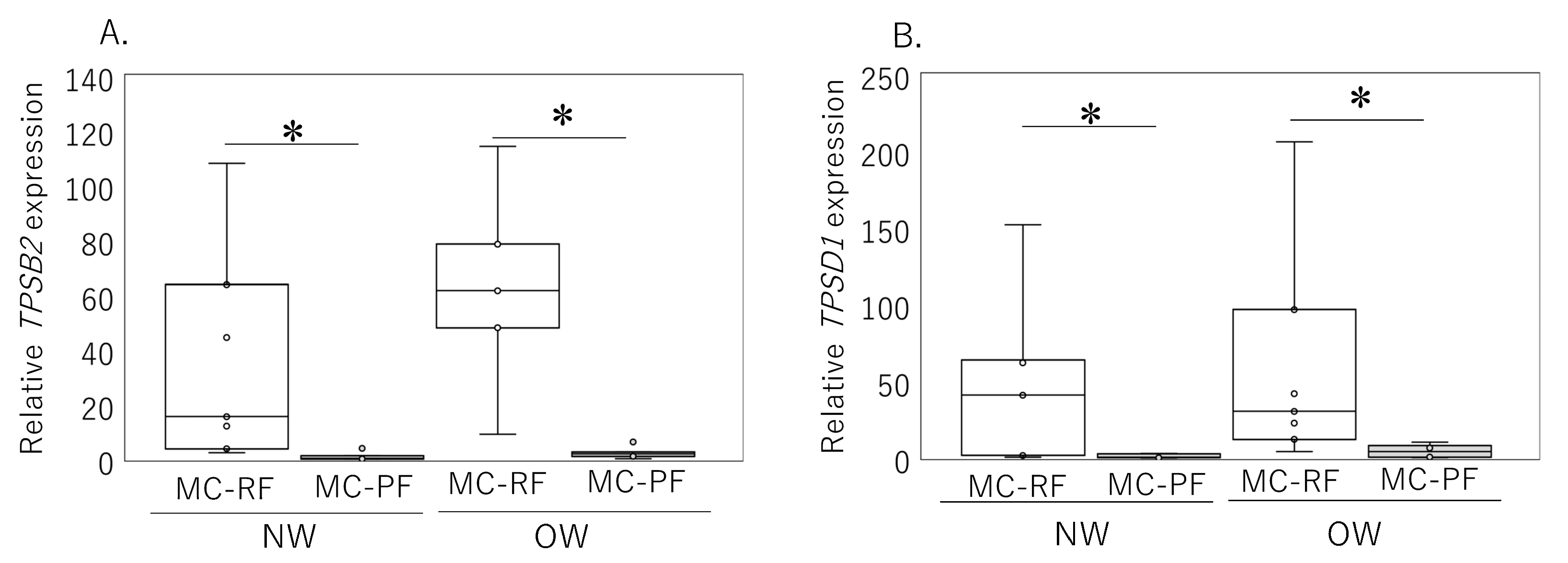Increase in TPSB2 and TPSD1 Expression in Synovium of Hip Osteoarthritis Patients Who Are Overweight
Abstract
1. Introduction
2. Results
2.1. Synovial Levels of TPSB2 and TPSD1 by BMI
2.2. Correlation between TSPB2 and TPSD1 Expression and Proinflammatory Cytokines
2.3. Tryptase Expression Levels in MCs Derived from the NW and OW Groups
3. Discussion
4. Material and Methods
4.1. Patients
4.2. Clinical Assessment
4.3. qPCR
4.4. Magnetic Isolation of MC
4.5. Statistical Analysis
5. Conclusions
Author Contributions
Funding
Institutional Review Board Statement
Informed Consent Statement
Data Availability Statement
Conflicts of Interest
References
- Cheng, K.Y.; Strotmeyer, E.S.; Kado, D.M.; Schousboe, J.T.; Schenk, S.; Nevitt, M.; Lane, N.E.; Hughes-Austin, J.M. The Association of Metabolic Syndrome and Obesity With Clinical Hip Osteoarthritis in the Study of Osteoporotic Fractures and the Osteoporotic Fractures in Men Study Cohorts. ACR Open Rheumatol. 2023, 5, 115–123. [Google Scholar] [CrossRef]
- Gelber, A.C. Obesity and hip osteoarthritis: The weight of the evidence is increasing. Am. J. Med. 2003, 114, 158–159. [Google Scholar] [CrossRef] [PubMed]
- Ji, S.; Liu, L.; Li, J.; Zhao, G.; Cai, Y.; Dong, Y.; Wang, J.; Wu, S. Prevalence and factors associated with knee osteoarthritis among middle-aged and elderly individuals in rural Tianjin: A population-based cross-sectional study. J. Orthop. Surg. Res. 2023, 18, 266. [Google Scholar] [CrossRef] [PubMed]
- Murphy, N.J.; Eyles, J.P.; Hunter, D.J. Hip Osteoarthritis: Etiopathogenesis and Implications for Management. Adv. Ther. 2016, 33, 1921–1946. [Google Scholar] [CrossRef]
- Park, J.M. Association between obesity and osteoarthritis in the South Korean older population: A nationwide population-based study. Medicine 2023, 102, e33455. [Google Scholar] [CrossRef]
- Jones, G.C.; Riley, G.P.; Buttle, D.J. The role of proteases in pathologies of the synovial joint. Int. J. Biochem. Cell Biol. 2008, 40, 1199–1218. [Google Scholar] [CrossRef] [PubMed]
- Sanchez-Lopez, E.; Coras, R.; Torres, A.; Lane, N.E.; Guma, M. Synovial inflammation in osteoarthritis progression. Nat. Rev. Rheumatol. 2022, 18, 258–275. [Google Scholar] [CrossRef]
- Maun, H.R.; Jackman, J.K.; Choy, D.F.; Loyet, K.M.; Staton, T.L.; Jia, G.; Dressen, A.; Hackney, J.A.; Bremer, M.; Walters, B.T.; et al. An Allosteric Anti-tryptase Antibody for the Treatment of Mast Cell-Mediated Severe Asthma. Cell 2019, 179, 417–431.e19. [Google Scholar] [CrossRef]
- Sommerhoff, C.P.; Schaschke, N. Mast cell tryptase beta as a target in allergic inflammation: An evolving story. Curr. Pharm. Des. 2007, 13, 313–332. [Google Scholar] [CrossRef]
- Das, N.; de Almeida, L.G.N.; Derakhshani, A.; Young, D.; Mehdinejadiani, K.; Salo, P.; Rezansoff, A.; Jay, G.D.; Sommerhoff, C.P.; Schmidt, T.A.; et al. Tryptase beta regulation of joint lubrication and inflammation via proteoglycan-4 in osteoarthritis. Nat. Commun. 2023, 14, 1910. [Google Scholar] [CrossRef]
- Nanus, D.E.; Wijesinghe, S.N.; Pearson, M.J.; Hadjicharalambous, M.R.; Rosser, A.; Davis, E.T.; Lindsay, M.A.; Jones, S.W. Regulation of the Inflammatory Synovial Fibroblast Phenotype by Metastasis-Associated Lung Adenocarcinoma Transcript 1 Long Noncoding RNA in Obese Patients With Osteoarthritis. Arthritis Rheumatol. 2020, 72, 609–619. [Google Scholar] [CrossRef]
- Wang, Q.; Lepus, C.M.; Raghu, H.; Reber, L.L.; Tsai, M.M.; Wong, H.H.; von Kaeppler, E.; Lingampalli, N.; Bloom, M.S.; Hu, N.; et al. IgE-mediated mast cell activation promotes inflammation and cartilage destruction in osteoarthritis. eLife 2019, 8, e39905. [Google Scholar] [CrossRef]
- Takata, K.; Uchida, K.; Mukai, M.; Takano, S.; Aikawa, J.; Iwase, D.; Sekiguchi, H.; Miyagi, M.; Inoue, G.; Takaso, M. Increase in Tryptase and Its Role in the Synovial Membrane of Overweight and Obese Patients with Osteoarthritis of the Knee. Diabetes Metab. Syndr. Obes. 2020, 13, 1491–1497. [Google Scholar] [CrossRef]
- Tsukada, A.; Takata, K.; Takano, S.; Ohashi, Y.; Mukai, M.; Aikawa, J.; Iwase, D.; Inoue, G.; Takaso, M.; Uchida, K. Increased NMUR1 Expression in Mast Cells in the Synovial Membrane of Obese Osteoarthritis Patients. Int. J. Mol. Sci. 2022, 23, 11237. [Google Scholar] [CrossRef]
- Uchida, K.; Takano, S.; Inoue, G.; Iwase, D.; Aikawa, J.; Takata, K.; Tazawa, R.; Kawakubo, A.; Sekiguchi, H.; Takaso, M. Increase in mast cell marker expression in the synovium of obese patients with osteoarthritis of the knee. Diabetes Metab. Syndr. Obes. 2019, 12, 377–382. [Google Scholar] [CrossRef] [PubMed]
- Hallgren, J.; Pejler, G. Biology of mast cell tryptase. An inflammatory mediator. FEBS J. 2006, 273, 1871–1895. [Google Scholar] [CrossRef] [PubMed]
- Sommerhoff, C.P.; Bode, W.; Pereira, P.J.; Stubbs, M.T.; Sturzebecher, J.; Piechottka, G.P.; Matschiner, G.; Bergner, A. The structure of the human betaII-tryptase tetramer: Fo(u)r better or worse. Proc. Natl. Acad. Sci. USA 1999, 96, 10984–10991. [Google Scholar] [CrossRef]
- Nakano, S.; Mishiro, T.; Takahara, S.; Yokoi, H.; Hamada, D.; Yukata, K.; Takata, Y.; Goto, T.; Egawa, H.; Yasuoka, S.; et al. Distinct expression of mast cell tryptase and protease activated receptor-2 in synovia of rheumatoid arthritis and osteoarthritis. Clin. Rheumatol. 2007, 26, 1284–1292. [Google Scholar] [CrossRef]
- Caughey, G.H. Mast cell tryptases and chymases in inflammation and host defense. Immunol. Rev. 2007, 217, 141–154. [Google Scholar] [CrossRef] [PubMed]
- Pallaoro, M.; Fejzo, M.S.; Shayesteh, L.; Blount, J.L.; Caughey, G.H. Characterization of genes encoding known and novel human mast cell tryptases on chromosome 16p13.3. J. Biol. Chem. 1999, 274, 3355–3362. [Google Scholar] [CrossRef]
- Kennedy, R.B.; Oberg, A.L.; Ovsyannikova, I.G.; Haralambieva, I.H.; Grill, D.; Poland, G.A. Transcriptomic profiles of high and low antibody responders to smallpox vaccine. Genes Immun. 2013, 14, 277–285. [Google Scholar] [CrossRef]
- Mathiessen, A.; Conaghan, P.G. Synovitis in osteoarthritis: Current understanding with therapeutic implications. Arthritis Res. Ther. 2017, 19, 18. [Google Scholar] [CrossRef]
- Rahmati, M.; Mobasheri, A.; Mozafari, M. Inflammatory mediators in osteoarthritis: A critical review of the state-of-the-art, current prospects, and future challenges. Bone 2016, 85, 81–90. [Google Scholar] [CrossRef]
- Malamud, V.; Vaaknin, A.; Abramsky, O.; Mor, M.; Burgess, L.E.; Ben-Yehudah, A.; Lorberboum-Galski, H. Tryptase activates peripheral blood mononuclear cells causing the synthesis and release of TNFAlpha, IL6 and IL1Beta: Possible relevance to multiple sclerosis. J. Neuroimmunol. 2003, 138, 115–122. [Google Scholar] [CrossRef] [PubMed]
- Zhang, S.; Zeng, X.; Yang, H.; Hu, G.; He, S. Mast cell tryptase induces microglia activation via protease-activated receptor 2 signaling. Cell. Physiol. Biochem. 2012, 29, 931–940. [Google Scholar] [CrossRef] [PubMed]
- Bangert, C.; Villazala-Merino, S.; Fahrenberger, M.; Krausgruber, T.; Bauer, W.M.; Stanek, V.; Campion, N.J.; Bartosik, T.; Quint, T.; Regelsberger, G.; et al. Comprehensive Analysis of Nasal Polyps Reveals a More Pronounced Type 2 Transcriptomic Profile of Epithelial Cells and Mast Cells in Aspirin-Exacerbated Respiratory Disease. Front. Immunol. 2022, 13, 850494. [Google Scholar] [CrossRef]
- Rai, M.F.; Cai, L.; Tycksen, E.D.; Chamberlain, A.; Keener, J. RNA-Seq analysis reveals sex-dependent transcriptomic profiles of human subacromial bursa stratified by tear etiology. J. Orthop. Res. 2022, 40, 2713–2727. [Google Scholar] [CrossRef]
- Farah, H.; Wijesinghe, S.N.; Nicholson, T.; Alnajjar, F.; Certo, M.; Alghamdi, A.; Davis, E.T.; Young, S.P.; Mauro, C.; Jones, S.W. Differential Metabotypes in Synovial Fibroblasts and Synovial Fluid in Hip Osteoarthritis Patients Support Inflammatory Responses. Int. J. Mol. Sci. 2022, 23, 3266. [Google Scholar] [CrossRef] [PubMed]
- Wijesinghe, S.N.; Badoume, A.; Nanus, D.E.; Sharma-Oates, A.; Farah, H.; Certo, M.; Alnajjar, F.; Davis, E.T.; Mauro, C.; Lindsay, M.A.; et al. Obesity defined molecular endotypes in the synovium of patients with osteoarthritis provides a rationale for therapeutic targeting of fibroblast subsets. Clin. Transl. Med. 2023, 13, e1232. [Google Scholar] [CrossRef]
- Jogie-Brahim, S.; Min, H.K.; Fukuoka, Y.; Xia, H.Z.; Schwartz, L.B. Expression of alpha-tryptase and beta-tryptase by human basophils. J. Allergy Clin. Immunol. 2004, 113, 1086–1092. [Google Scholar] [CrossRef]
- Kovalenko, B.; Bremjit, P.; Fernando, N. Classifications in Brief: Tonnis Classification of Hip Osteoarthritis. Clin. Orthop. Relat. Res. 2018, 476, 1680–1684. [Google Scholar] [CrossRef] [PubMed]



| qPCR | Magnetic Isolation | |||||
|---|---|---|---|---|---|---|
| NW (n = 25) | OW (n = 21) | p | NW (n = 7) | OW (n = 7) | p | |
| Age (years) | 62.6 ± 9.8 | 63.0 ± 12.9 | 0.732 | 60.6 ± 13.1 | 58.4 ± 7.8 | 0.456 |
| Tönnis (2/3), n | 8/17 | 11/10 | 0.167 | 4/3 | 2/5 | 0.383 |
| BMI (kg/m2) | 21.9 ± 2.2 | 27.1 ± 1.4 | <0.001 | 22.6 ± 1.34 | 26.5 ± 1.3 | <0.001 |
| Gene | Direction | Primer Sequence (5′–3′) | Product Size (bp) |
|---|---|---|---|
| TPSB2 | F | CGCAAAATACCACCTTGGCG | 138 |
| R | GTGCCATTCACCTTGCACAC | ||
| TPSD1 | F | CGGAATATCACACCGGCCTC | 135 |
| R | TGCCATTCACCTTGCAGACC | ||
| TNFA | F | CTTCTGCCTGCTGCACTTTG | 118 |
| R | GTCACTCGGGGTTCGAGAAG | ||
| IL1B | F | GTACCTGTCCTGCGTGTTGA | 153 |
| R | GGGAACTGGGCAGACTCAAA | ||
| IL6 | F | GAGGAGACTTGCCTGGTGAA | 199 |
| R | TGGCATTTGTGGTTGGGTCA | ||
| GAPDH | F | TGTTGCCATCAATGACCCCTT | 202 |
| R | CTCCACGACGTACTCAGCG |
Disclaimer/Publisher’s Note: The statements, opinions and data contained in all publications are solely those of the individual author(s) and contributor(s) and not of MDPI and/or the editor(s). MDPI and/or the editor(s) disclaim responsibility for any injury to people or property resulting from any ideas, methods, instructions or products referred to in the content. |
© 2023 by the authors. Licensee MDPI, Basel, Switzerland. This article is an open access article distributed under the terms and conditions of the Creative Commons Attribution (CC BY) license (https://creativecommons.org/licenses/by/4.0/).
Share and Cite
Tsuchiya, M.; Fukushima, K.; Takata, K.; Ohashi, Y.; Uchiyama, K.; Takahira, N.; Saito, H.; Tsukada, A.; Inoue, G.; Takaso, M.; et al. Increase in TPSB2 and TPSD1 Expression in Synovium of Hip Osteoarthritis Patients Who Are Overweight. Int. J. Mol. Sci. 2023, 24, 11532. https://doi.org/10.3390/ijms241411532
Tsuchiya M, Fukushima K, Takata K, Ohashi Y, Uchiyama K, Takahira N, Saito H, Tsukada A, Inoue G, Takaso M, et al. Increase in TPSB2 and TPSD1 Expression in Synovium of Hip Osteoarthritis Patients Who Are Overweight. International Journal of Molecular Sciences. 2023; 24(14):11532. https://doi.org/10.3390/ijms241411532
Chicago/Turabian StyleTsuchiya, Maho, Kensuke Fukushima, Ken Takata, Yoshihisa Ohashi, Katsufumi Uchiyama, Naonobu Takahira, Hiroki Saito, Ayumi Tsukada, Gen Inoue, Masashi Takaso, and et al. 2023. "Increase in TPSB2 and TPSD1 Expression in Synovium of Hip Osteoarthritis Patients Who Are Overweight" International Journal of Molecular Sciences 24, no. 14: 11532. https://doi.org/10.3390/ijms241411532
APA StyleTsuchiya, M., Fukushima, K., Takata, K., Ohashi, Y., Uchiyama, K., Takahira, N., Saito, H., Tsukada, A., Inoue, G., Takaso, M., & Uchida, K. (2023). Increase in TPSB2 and TPSD1 Expression in Synovium of Hip Osteoarthritis Patients Who Are Overweight. International Journal of Molecular Sciences, 24(14), 11532. https://doi.org/10.3390/ijms241411532






